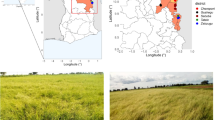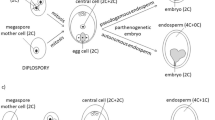Abstract
Self-incompatibility, a common attribute of plant development, forms a classical paradigm of balancing selection in natural populations, in particular negative frequency-dependent selection. Under negative frequency-dependent selection population genetics theory predicts that the S-locus, being in command of self-incompatibility, keeps numerous alleles in equal frequencies demonstrating a wide allelic range. Moreover, while natural populations exhibit a higher within population genetic diversity, a reduction of population differentiation and increase of effective migration rate is expected in comparison to neutral loci. Allelic frequencies were investigated in terms of distribution and genetic structure at the gametophytic self-incompatibility locus in five wild cherry (Prunus avium L.) populations. Comparisons were also made between the differentiation at the S-locus and at the SSR loci. Theoretical expectations under balancing selection were congruent to the results observed. The S-locus showed broad multiplicity (16 S-alleles), high genetic diversity, and allelic isoplethy. Genetic structure at the self-incompatibility locus was almost four times lower than at 11 nSSR loci. Analysis of molecular variance revealed that only 5 % of the total genetic variation concerns differentiation among populations. In conclusion, the wealth of S-allelic diversity found in natural wild cherry populations in Greece is useful not only in advancing basic population genetics research of self-incompatibility systems in wild cherry but also in the development of breeding programs.



Similar content being viewed by others
References
Arunyawat U, Capdeville G, Decroocq V, Mariette S (2012) Linkage disequilibrium in French wild cherry germplasm and worldwide sweet cherry germplasm. Tree Genet Genom. doi:10.1007/s11295-011-0460-9
Barrett SCH (2002) The evolution of plant sexual diversity. Nat Rev Genet 3:274–284
Barrett SCH (2003) Mating strategies in flowering plants: the outcrossing-selfing paradigm and beyond. Philos T Roy Soc B 358:991–1004
Bošković R, Tobutt KR (1996) Correlation of stylar ribonuclease zymograms with incompatibility alleles in sweet cherry. Euphytica 90:245–250
Boskovic R, Tobutt KR (2001) Genotyping cherry cultivars assigned to incompatibility groups, by analysing stylar ribonucleases. Theor Appl Genet 103:475–485
Brennan AC, Harris SA, Tabah DA, Hiscock SJ (2002) The population genetics of sporophytic self-incompatibility in Senecio squalidus L. (Asteraceae) I: S allele diversity in a natural population. Heredity 89:430–438
Busch JW, Schoen DJ (2008) The evolution of self-incompatibility when mates are limiting. Trends Plant Sci 13:128–136
Cachi AM, Wünsch A (2011) Characterization and mapping of non-S gametophytic self-compatibility in sweet cherry (Prunus avium L.). J Exp Bot 62:1847–1856
Campbell JM, Lawrence MJ (1981) The population genetics of the self-incompatibility polymorphism in Papaver rhoeas. II. The number and frequency of S-alleles in a natural population. Heredity 46:81–90
Castric V, Vekemans X (2004) Plant self-incompatibility in natural populations: a critical assessment of recent theoretical and empirical advances. Mol Ecol 13:2873–2889
Choi C, Ta R, Andersen RL (2002) Identification of self-incompatibility alleles and pollen incompatibility groups in sweet cherry by PCR based S-allele typing and controlled pollination. Euphytica 123:9–20
De Cuyper B, Sonneveld T, Tobutt KR (2005) Determining self-incompatibility genotypes in Belgian wild cherries. Mol Ecol 14:945–955
Doyle JJ, Doyle JL (1987) A rapid DNA isolation procedure for small quantities of fresh leaf tissue. Phytochem Bull 19:11–15
Ewens WJ (1972) The sampling theory of selectively neutral alleles. Theor Popul Biol 3:87–112
Excoffier L, Smouse P, Quattro J (1992) Analysis of molecular variance inferred from metric distances among DNA haplotypes: application to human mitochondrial DNA restriction data. Genetics 131:479–491
Excoffier L, Laval G, Schneider S (2005) Arlequin ver. 3.0: an integrated software package for population genetics data analysis. Evol Bioinform Online 1:47–50
Franklin-Tong VE, Franklin FCH (2003) The different mechanisms of gametophytic self-incompatibility. Philos T Roy Soc B 358:1025–1032
Ganopoulos IV, Argiriou A, Tsaftaris AS (2010) Determination of self-incompatible genotypes in 21 cultivated sweet cherry cultivars in Greece and implications for orchard cultivation. J Hortic Sci Biotech 85:444–448
Ganopoulos I, Aravanopoulos F, Argiriou A, Kalivas A, Tsaftaris A (2011) Is the genetic diversity of small scattered forest tree populations at the southern limits of their range more prone to stochastic events? A wild cherry case study by microsatellite-based markers. Tree Genet Genom 7:1299–1313
Ganopoulos IV, Aravanopoulos FA, Tsaftaris A (2012) Genetic differentiation and gene flow between wild and cultivated Prunus avium: an analysis of molecular genetic evidence at a regional scale. Plant Biosyst (accepted)
Garrigan D, Hedrick PW (2003) Perspective: detecting adaptive molecular polymorphism: lessons from the MHC. Evolution 57:1707–1722
Gisbert AD, Badenes ML, Tobutt KR, Llacer G, Romero C (2008) Determination of the S-allele composition of sweet cherry (Prunus avium L.) cultivars grown in the southeast of Spain by PCR analysis. J Hortic Sci Biotech 83:246–252
Glémin S, Gaude T, Guillemin M-L, Lourmas M, Olivieri I, As M (2005) Balancing selection in the wild: testing population genetics theory of self-incompatibility in the rare species Brassica insularis. Genetics 171:279–289
Goudet J (1995) Fstat (version 1.2); a computer program to calculate F-statistics. J Hered 86:485–486
Hartl D, Clark A (2006) Principles of Population Genetics, edn. Sinauer Associates, Inc, Sunderland
Hauck NR, Yamane H, Tao R, Iezzoni AF (2002) Self-compatibility and incompatibility in tetraploid sour cherry (Prunus cerasus L.). Sex Plant Reprod 15:39–46
Holderegger R, Häner R, Csencsics D, Angelone S, Hoebee SE (2008) S-allele diversity suggests no mate limitation in small populations of a self-incompatible plant. Evolution 62:2922–2928
Ipek A, Gulen H, Akcay ME, Ipek M, Ergin S, Eris A (2011) Determination of self-incompatibility groups of sweet cherry genotypes from Turkey. Genet Mol Res 10(1):253–260
Kalinowski ST (2005) Hp-rare 1.0: a computer program for performing rarefaction on measures of allelic richness. Mol Ecol Notes 5:187–189
Kamau E, Charlesworth B, Charlesworth D (2007) Linkage disequilibrium and recombination rate estimates in the self-incompatibility region of Arabidopsis lyrata. Genetics 176:2357–2369
Kato S, Mukai Y (2004) Allelic diversity of S-RNase at the self-incompatibility locus in natural flowering cherry populations (Prunus lannesiana var. speciosa). Heredity 92:249–256
Kawabe A, Hansson B, Forrest A, Hagenblad J, Charlesworth D (2006) Comparative gene mapping in Arabidopsis lyrata chromosomes 6 and 7 and A. thaliana chromosome IV: evolutionary history, rearrangements and local recombination rates. Genet Res 88:45–56
Lawrence MJ (2000) Population genetics of the homomorphic self-incompatibility polymorphisms in flowering plants. Ann Bot 85:221–226
Manly BFJ (1985) The Statistics of Natural Selection on Animal Populations. Chapman and Hall, London
Mantel N (1974) Some reasons for not using the Yates continuity correction on 2 × 2 contingency tables: comment and a suggestion. Amer Statist Assoc 69:378–380
Marchese A, Tobutt KR, Raimondo A, Motisi A, Boskovic RI, Clarke J, Caruso T (2007) Morphological characteristics, microsatellite fingerprinting and determination of incompatibility genotypes of Sicilian sweet cherry cultivars. J Hortic Sci Biotech 82:41–48
Maruyama T, Nei M (1981) Genetic variability maintained by mutation and overdominant selection in finite populations. Genetics 98:441–459
Michalakis Y, Excoffier L (1996) A generic estimation of population subdivision using distances between alleles with special reference for microsatellite loci. Genetics 142:1061–1064
Muirhead CA (2001) Consequences of population structure on genes under balancing selection. Evolution 55:1532–1541
Newbigin E, Paape T, Kohn JR (2008) RNase-based self-incompatibility: puzzled by pollen S. Plant Cell 20:2286–2292
Paxman GJ (1963) The maximum likelihood estimation of the number of self-sterility alleles in a population. Genetics 48:1029–1032
Peakall R, Smouse P (2006) Genalex 6: genetic analysis in Excel. Population genetic software for teaching and research. Mol Ecol Notes 6:288–295
Schierup MH (1998) The number of self-incompatibility alleles in a finite, subdivided population. Genetics 149:1153–1162
Schueler S, Tusch A, Scholz F (2006) Comparative analysis of the within-population genetic structure in wild cherry (Prunus avium L.) at the self-incompatibility locus and nuclear microsatellites. Mol Ecol 15:3231–3243
Schuster M, Flachowsky H, Kohler D (2007) Determination of self-incompatible genotypes in sweet cherry (Prunus avium L.) accessions and cultivars of the German Fruit Gene Bank and from private collections. Plant Breeding 126:533–540
Sonneveld T, Robbins TP, Boskovic R, Tobutt KR (2001) Cloning of six cherry self-incompatibility alleles and development of allele-specific PCR detection. Theor Appl Genet 102:1046–1055
Sonneveld T, Tobutt KR, Robbins TP (2003) Allele-specific PCR detection of sweet cherry self-incompatibility (S) alleles S1 to S16 using consensus and allele-specific primers. Theor Appl Genet 107:1059–1070
Sonneveld T, Robbins TP, Tobutt KR (2006) Improved discrimination of self-incompatibility S-RNase alleles in cherry and high throughput genotyping by automated sizing of first intron polymerase chain reaction products. Plant Breeding 125:305–307
Steiner W, Gregorius H-R (1999) Incompatibility and pollen competition in Alnus glutinosa: evidence from pollination experiments. Genetica 105:259–271
Stoeckel S, Grange J, Fernandez-Manjarres J, Bilger I, Frascaria-Lacoste N, Mariette S (2006) Heterozygote excess in a self-incompatible and partially clonal forest tree species—Prunus avium L. Mol Ecol 15:2109–2118
Stoeckel S, Castric V, Mariette S, Vekemans X (2008) Unequal allelic frequencies at the self-incompatibility locus within local populations of Prunus avium L.: an effect of population structure? J Evolution Biol 21:889–899
Stoeckel S, Klein EK, Oddou-Muratorio S, Musch B, Mariette S (2011) Microevolution of S-allele frequencies in wild cherry populations: respective impacts of negative frequency dependent selection and genetic drift. Evolution (in press)
Tao R, Yamane H, Sugiura A, Murayama H, Sassa H, Mori H (1999) Molecular typing of S-alleles through identification, characterization and cDNA cloning for S-RNases in sweet cherry. J Am Soc Hortic Sci 124:224–233
Vaughan SP, Boskovic RI, Gisbert-Climent A, Russell K, Tobutt KR (2008) Characterisation of novel S-alleles from cherry (Prunus avium L.). Tree Genet Genom 4(3):531–541
Watterson GA (1974) The sampling theory of selectively neutral alleles. Adv Appl Probab 6:463–488
Weir B, Cockerham C (1984) Estimating F-statistics for the analysis of population structure. Evolution 38:1358–1370
Wright S (1939) The distribution of self-sterility alleles in populations. Genetics 24:538–552
Yamane H, Tao R, Murayama H, Ishiguro M, Abe Y, Soejima J, Sugiura A (2000) Determining S- genotypes of two sweet cherry (Prunus avium L.) cultivars, ‘Takasago (Rockport Bigarreau)’ and ‘Hinode (Early Purple)’. J Japan Soc Hort Sci Hort Res 69:29–34
Yamane H, Ikeda K, Ushijima K, Sassa H, Tao R (2003) A pollen-expressed gene for a novel protein with an F-box motif that is very tightly linked to a gene for S-RNase in two species of cherry, Prunus cerasus and P-avium. Plant Cell Physiol 44:764–769
Zhou L, Kappel F, MacDonald R, Hampson C, Bakkeren G, Wiersma PA (2002) Determination of S-genotypes and self-fertility of sweet cherry in Summerland advanced selections. J Am Pomol Soc 56:173–179
Acknowledgments
This research has been co-financed by the European Union (European Social Fund—ESF) and Hellenic national funds through the Operational Program “Education and Lifelong Learning” of the National Strategic Reference Framework (NSRF)—Research Funding Program: Heracletus II. Continuous support for the Institute of Agrobiotechnology/CERTH from the General Secretariat of Research and Technology of Greece is also acknowledged.
Author information
Authors and Affiliations
Corresponding author
Additional information
Communicated by A. Dandekar
Ioannis Ganopoulos and Filippos Aravanopoulos contributed equally to this work.
Rights and permissions
About this article
Cite this article
Ganopoulos, I., Aravanopoulos, F., Argiriou, A. et al. Genome and population dynamics under selection and neutrality: an example of S-allele diversity in wild cherry (Prunus avium L.). Tree Genetics & Genomes 8, 1181–1190 (2012). https://doi.org/10.1007/s11295-012-0504-9
Received:
Revised:
Accepted:
Published:
Issue Date:
DOI: https://doi.org/10.1007/s11295-012-0504-9




